Marvel’s series Hit-Monkey, now streaming on Hulu, tells the tale of a Japanese snow monkey guided by a ghost assassin. When Bryce Fowler (Jason Sudeikis) is hired to kill a Japanese politician, he heads out on the mission — only to be eliminated by his employer after finishing the job. Bryce flees to the mountains, wounded, where he is aided by a group of intelligent snow monkeys. But eventually Bryce’s employer’s assassins catch up with him and he is killed, along with every snow monkey but one. With the help of the ghost of Bryce, the remaining snow monkey (Fred Tatasciore) goes on a revenge quest through the Yakuza underworld.
Marvel’s Hit-Monkey series is based off of the comic of the same name, by Dalibor Talajic and Daniel Way. It’s an action-packed, sometimes comedic, adult series created by Will Speck and Josh Gordon, with animation by Floyd County Productions. We caught up with the crew behind Hit-Monkey to learn more about the series and the animation process. Read on for insights from J. West Hickman (Animation Director), and lead animators Jason Barnes (2D VFX), Victoria Alexander, and Tim Kafarantis.
How did Floyd County Productions get onto the series Hit-Monkey?
J. West: We produced a short pitch presentation a few years ago. We were up against some really awesome studios who made beautifully crafted tests. Obviously we wanted it to look stylish and impress everyone, but I like to think our attention to storytelling ended up getting us the gig. We were really focused on showcasing as much as we could in two minutes. Brutal hyperviolence, physical comedy, a sweet relationship moment, and noodles. We love noodles.
Jason: We had done a couple bids for Marvel projects in the past, and that kept the door open for this opportunity. And, we’d previously worked with Marvel on their show Legion, animating some sequences here and there for their first season. So, a simple relationship bound by contracts is what ultimately led us to Hit-Monkey.
Tim: The first step to getting onto Hit-Monkey was creating an animated pitch for Marvel/Hulu. The pitch was meant to show how the series would look and feel, and how Bryce and Monkey would interact with each other.
What attracted your team to the series, and how familiar was your team with the comic?
J. West: It’s Marvel, so there is built-in pedigree and mainstream appeal, but not everyone knows the Hit-Monkey comics. We have a lot of comic book readers on the team, but not that many folks had read it previously. It was cool to come in fresh and become fans as we made it. We got to do a lot of fun, weird stuff with this show. I am a huge fan of Paul Verhoeven, so I’m all about subversive, “mainstream”, blockbustery films and programs. Make weird stuff and trick your parents into watching it.
Victoria: I was aware of the comic, but had never read it before. What drew me to the project was that I’m really fond of animating animal characters. I was excited about Hit-Monkey because it has animals, and also just a really fun and weird premise.
Tim: We have a lot of comic lovers at Floyd County Productions, and comic artists as well! So, we were somewhat familiar with Hit-Monkey from the comic and had seen him in some Deadpool comics as well.
There was a lot that attracted us to the series, but if I had to name one thing, I would say the action! Using Toon Boom Harmony allowed us to redraw as we needed to make these action scenes work great. Whether it was Monkey jumping car to car, or Lady Bullseye on a motorcycle, it was a lot of fun to work on.
Jason: Marvel is a behemoth in the entertainment industry. We knew we’d be in good company by hooking up with them to work on Hit-Monkey. I personally was unfamiliar with the comic, but early on I found out it was Deadpool-adjacent, and that was super exciting for me.
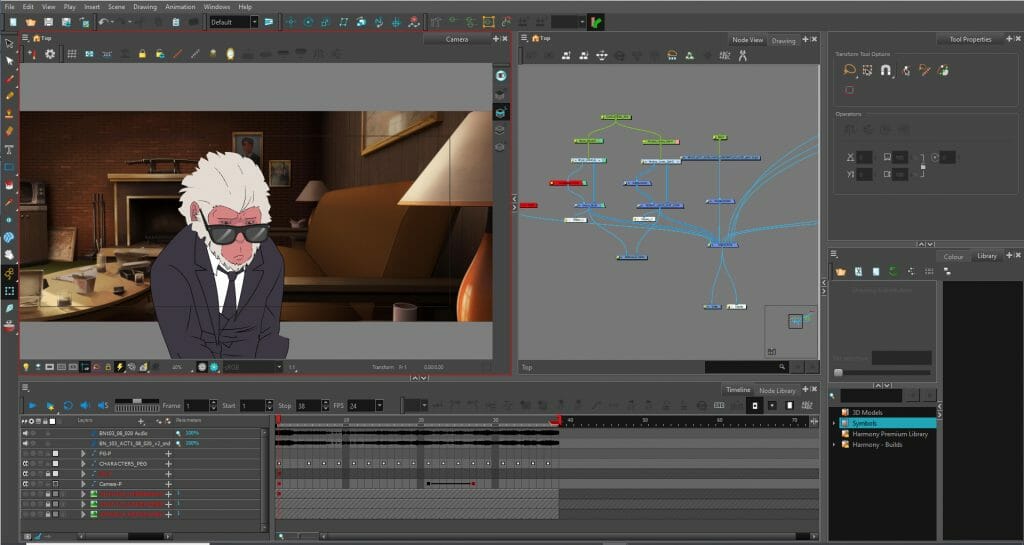
Were there any challenges in adapting Bryce and Monkey, and how did you overcome them?
J. West: Every element of the production was a challenge, but we had a lot of great material to work with. The Hit-Monkey comics have a nuanced and unique tone built-in. It turns out, adapting that small amount of material into 10 half-hour episodes is like… a TON of work. The biggest challenge with any completely new animated show is the pilot. I have been doing this for over a decade, and I still underestimate how complicated pilots can be. So many moving parts and variables to account for, so much to establish. We experimented a ton at the beginning to figure out what worked for our team and made the show creators happy.
I think it really came down to digging into subtlety during the tender moments, and contrasting that with some fast-paced and surprising action sequences. I’m a huge fan of Shinichirō Watanabe. His sensibilities are so filmic and grounded. We definitely referenced the hell out of Cowboy Bebop. However, I think we looked at way more live action references, both for staging and motion. We shot a ton of footage. I love to shoot references, it gets the blood pumping.
Victoria: There was a bit of workshopping of Bryce on the pilot, to really nail down his personality and devil-may-care attitude. Early on, we had to go back and give him more of a pass to make him smile more, and a little less serious.
Tim: One of the biggest challenges was fitting the two characters on screen next to each other. Since they are different sizes, it can be difficult to fit them on the screen together in some angles while keeping a good composition. We had to get creative in some cases.
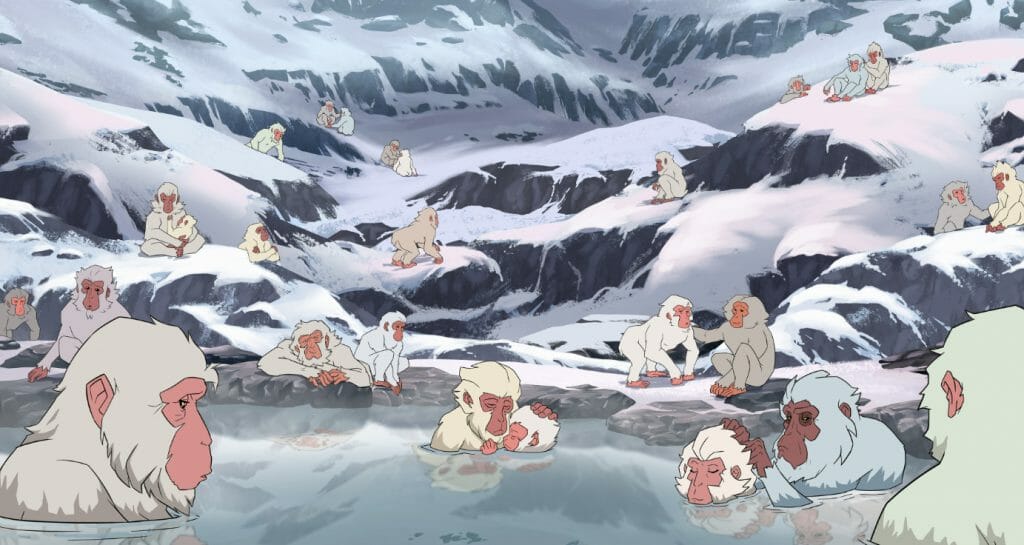
How does animating a non-human character compare to a human character?
J. West: Generally, I take a completely different approach when animating animals. I am usually thinking more about body mechanics than internal motivation unless the animal is anthropomorphic. This was not the case with Monkey. He needs to look and move like a believable macaque monkey, but he is also a little baby John Wick.
His movement style changes over the course of the first season as he becomes more fused with Bryce, and therefore more human. He can whip his body through the air and slice off a dude’s head in a second, but we also need to see the pain and humanity in his eyes. It was a strange and difficult thing to achieve. We had to be really deliberate about that aspect of the animation. I am super proud of our team for making that happen. Thank you to Victoria Alexander for being an observational genius, especially with animals.
Victoria: For Monkey, we had to be very deliberate in animating him differently from a human. He’s got shorter legs, longer arms, and moves in a way that doesn’t and shouldn’t feel human. We had to reference a lot of macaque videos to make sure he never loses that monkey-ness.
It was also very important to not use chimpanzee or gorilla movement for reference, because they move differently than macaques. For example, the oft-referenced knuckle-driven gait of chimpanzees isn’t the same as the more cat-like movements of macaques. We weren’t making a nature documentary, so there were liberties taken, but we definitely wanted to be sure that Monkey always looked like a monkey.
Tim: One of the more complicated aspects of animating Monkey was the quadruped walk. Even a biped walk can be challenging, but adding in two more feet, and then trying to make the weight shifting appear natural, is challenging. It was great giving Monkey the ability to go on two feet or on all fours. This broke things up a bit.
Jason: Yeah, walking and fight sequences were a challenge. Quadruped walks are always difficult for me, even after 13 years of animating! And then a fight scene with a quadrupled walk makes it even more complicated, but in a fun way. For example, getting Monkey from point A to point C, while killing point B, involved lots of creative decisions. In one scene, we landed on having Monkey use his feet to fire guns and wield swords.
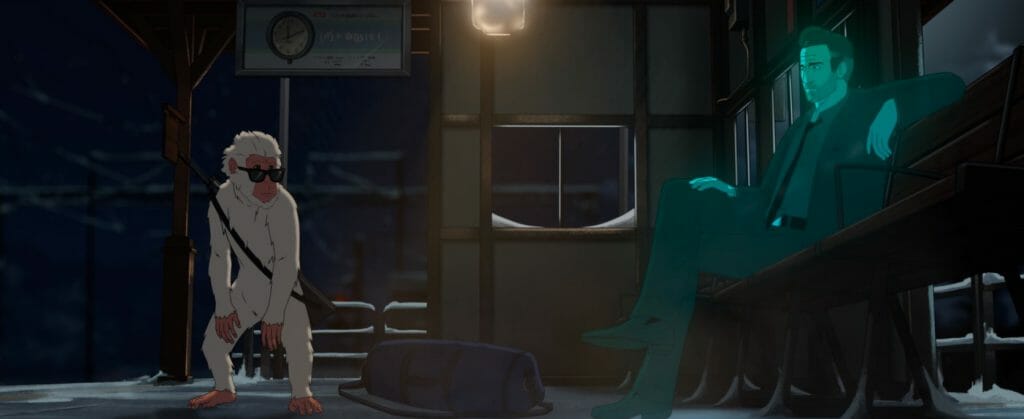
Can you share a bit about how your team approached constructing the series’ character rigs?
J. West: We built out some fairly robust deformation setups for our main characters, but generally we kept it simple. We knew a lot of the action would end up being done in a digital cel style, so we didn’t over-build our rigs. We were also on a tight schedule and had to pivot to work from home mid-production. So we couldn’t afford to spend weeks on a character rig.
Monkey’s fur is really detailed. Maintaining volume and secondary motion when he twists and turns in the air is pretty much impossible unless you draw it by hand. That being said, we used deformers extensively in our “cut-out” scenes, which makes up a decent bulk of the show. We love hybrid animation and we love doing it in Harmony. Freeform deformers are a life-saver.
Victoria: Almost paradoxically, using a simpler rig is better for characters that are going to be involved in a lot of action. It makes it easier to “break” the rig to get something more dynamic, and to encourage the animators to not rely as heavily on the rig for their character acting.
Tim: We kept the rigs as simple as we could for this project, letting the animators add to it as needed. This way we could really push redrawing the rig assets as much as possible. We wanted to get away from the puppet look where we could afford to, which is why working in Harmony is so great. It’s easy to throw a new drawing in the rig as you’re keying or tweening a shot.
Jason: The simpler the better. We went back and forth on complexity at the beginning but ultimately landed on a simple rig of pegs, and drawing nodes. Rarely would we use more advanced rigging features like auto patching. We knew that redrawing would be a huge part of the process, so keeping the rig open for that was key. However, DEFORMERS. Deformers are amazing. Always be deforming.
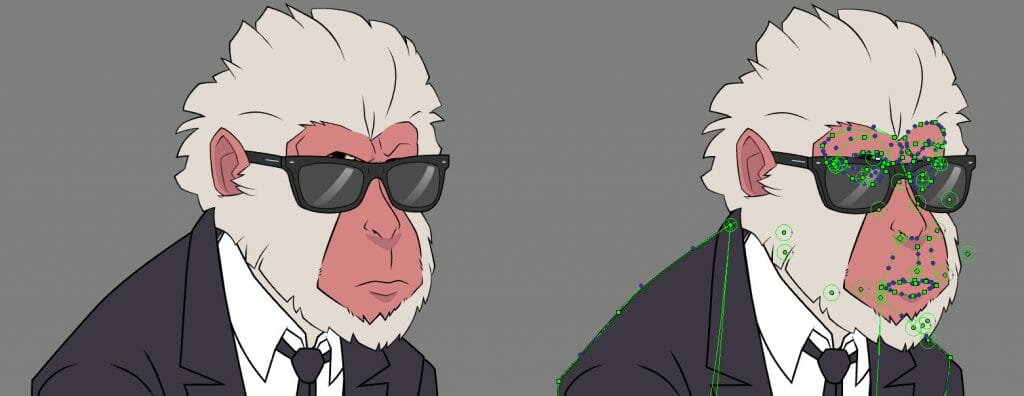
What was your team’s process for animating the series in 2D?
J. West: We broke the production up into ‘cutout’ or ‘puppeted’ versus ‘hand-drawn’ or ‘paperless’ shots. If the scene involved a lot of action, or extreme angles, it was more likely to be done without a rig, or with a very simplified one. If the scene had a lot of dialogue and closeup shots, we made use of our rigs. We avoided drawing rough animation in our cut-out shots to save time.
I know many productions will send these processes to separate teams, but we were all-hands-on-deck in-house. Everyone touched a little bit of everything. We all learned a ton and became much better animators and cinematographers by the end. We had a ton of help from some outside studios who specialized in cut-out and/or digital cel animation.
Victoria: The edit department starts by giving us the animatic — the storyboards, timed out to the audio — broken out into individual shots. If the scene is something simple, like a dialogue scene, our animators can start by adding the rigs to the scene and keying them out. That’s basically posing out the rig to hit all the main acting beats. A turn of the head, a shrug of the shoulder, a hand gesture. These will be broken out into a few poses.
If the scene is action-heavy, the animator will start with rough drawings instead. Once they’ve roughed out the timing and poses in drawings, they can bring in the rigs, and pose the rigs to match the rough drawings. Afterwards, the animator will “tween” the shot, which is the process of making all the images in between the keyframes. Toon Boom Harmony will get you most of the way there, but it requires some finessing to make sure that the animation doesn’t feel too stiff, or too robotic.
Tim: We would shoot references to start with. After that, it depends on if the shot was a rig shot, or a hand drawn shot. If it was a rig shot, the animator would drop the rig into the scene and start to pose out the keys. Once the keys were approved we would move to tweens. Likewise, if the shot was hand drawn, we would start with keys, then move onto the tweens phase next, then clean up and color.
Jason: For action scenes, I’d shoot ref or YouTube ref and blast through roughs to get an idea of flow and rough timing. These roughs became known as ‘spaghetti roughs’ because they were extremely loose, and often looked like piles of noodles! Then, I would go back and start doing breakdowns and cleaning up some of the poses, removing the spaghetti. Upon approval, a tiedown pass was next, and then colored, and then exported for composite.
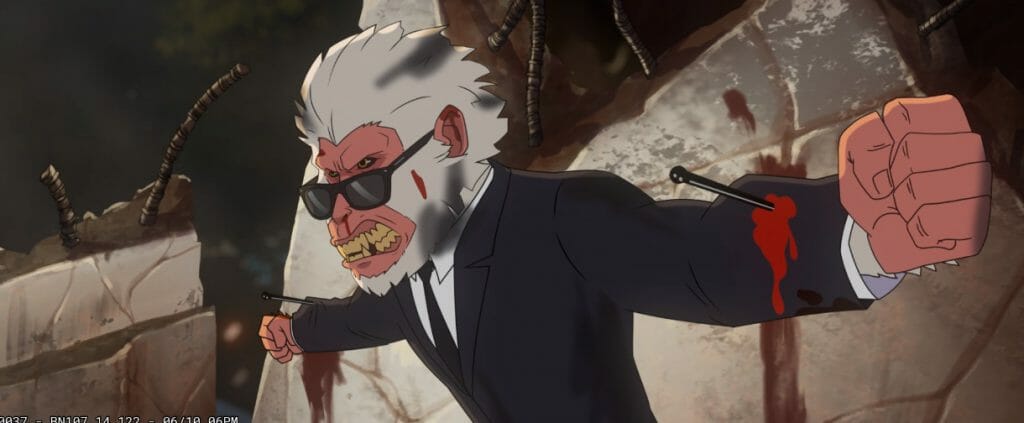
Can you describe any specific animation techniques that were useful for this series in particular?
J. West: Pretty much all of them! We used every tool in our toolbelt. We did some silhouetted music video-esq experimental scenes, used a lot of mixed media techniques in general. And we were lucky to have a brilliant and versatile 2D team, plus 3D animators who handled vehicles, 3D camera tracking, and environment mock-up, and an amazing compositing department to put it all together.
We always aimed for efficiency first, so we made sure to explore best practices before jumping into animation. If I knew a shot was going to be complicated, I did a ton of planning with our art directors, animators, bg artists, 3d animators and compositors to make sure all the parts would slot in together. Piecing Hit-Monkey together felt more like building a collage, than a series of drawings.
We definitely used some more old school techniques like manual parallax and frame by frame drawing but also utilized surface projection, deformation and all kinds of other fancy stuff. This was the most high-tech production I have ever worked on. We didn’t really paint highlights and lowlights very often. Our compositing department added a ton of specularity and volume to our animation. They are wizards.
Victoria: Maybe not a technique per se, but character acting is a pretty important aspect of this series, especially since the main character has to communicate with noises and gestures more than words. So, charades is probably a good thing to be good at!
Tim: I would say timing was particularly important. Timing, especially in the action scenes, was an animation technique that we imported on the project. Making some poses hold longer to read stronger, while others poses might only be held for a frame to make it pop, can really bring an action scene together.
In episode 1, when Monkey is fighting the snowmen in silhouette is a good example. If you go back and watch that sequence you’ll see different poses being held for different timing, but it all flows together.
Jason: I’m a huge fan of animating on 3s and 4s. I feel like if used correctly they can add weight and strength to an animation, while cutting down on the amount of drawings you later have to clean up. I would reference lots of Sakuga animation on Youtube, breaking down their timing and spacing.
Also, introducing camera work early on can troubleshoot an animation if staging isn’t working, or if the action is feeling stale. Sometimes the camera moving can mean the character doesn’t HAVE to move at all, saving time and money. I always pre-vis my camera work during roughs, especially for action sequences.
Can you share a bit about how scenes were animated with FX placeholders?
J. West: Any shot that was particularly dynamic would get a rough pass first. I worked with a small team of really talented “rough animators”. We planned out character animation, FX, camera movement, environmental and prop stuff as quickly and roughly as we could. Every detail in our storyboards and any additions requested by the creators and art directions would be considered at a very rudimentary level first, expanded up, and divided up between departments and specialists.
Some FX were generative, or composited stock footage, some were hand-drawn. Sometimes we would have dedicated 2D FX artists plan a whole shot out, including character animation, especially when the FX were the most important element.
Victoria: We had to work a bit side-by-side with the effects. Sometimes the effects were reactive to the main animation, like a character splashing in a pool. Those effects would be produced after the main character animation. Other times, the effects were the main thrust, like a character being hit by a beam of energy. Those often had the character animation take place afterwards, or sometimes the effects animator would also handle the character animation in that scene.
Jason: When I do character roughs, I always rough in the main idea for FX as well. Especially if they impact how we’ll see the character or if they’re directly interacting with the character. For example, for a guy being shot in the chest, I’d rough the character, map out where and when he’s being shot, then put some rough blood spray for the entry wound and exit wound, have it interact with his body movements, and track the wound over the character animation.
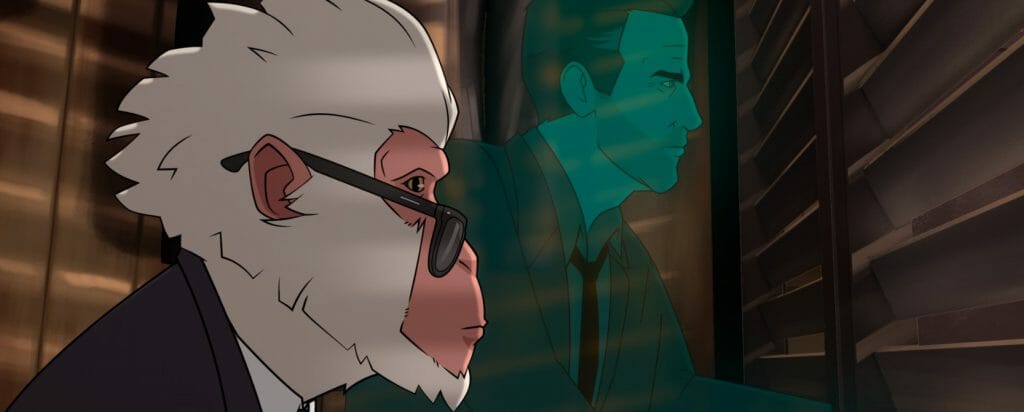
Are there any particular action scenes that you’re proud of, and would like to share a little bit about?
J. West: The Lady Bullseye car chase is really rad. A lot of thought goes into continuity when your characters are moving at highway speeds, jumping between vehicles, getting blown up, etc. Spoilers. The last few episodes have a lot of cool action scenes. The ghost man gets kneed in the nards by a mean lady in a mask. Watch it!
Victoria: It’s not much of an action scene, but I was pretty proud of a shot I animated of Elder monkey chewing up a fistful of grasses and herbs to help Bryce’s wound heal. To make the shot, I found a plant that grew in Northern Japan that supposedly had antiseptic properties. I was also pretty happy with the monkey acting from Elder. It was one of the earlier shots in the series where I felt that I was really getting a handle on the way the monkeys should move and behave.
Tim: In the final episode of the series, there is a huge action sequence that takes place with Silver Samurai chasing Yuki, Monkey, and Bryce up the side of a building. It’s a fun and exciting sequence with a ton of action! It was a perfect mix of hand drawn animation, rig animation, and FX working together. We had some great talent working on that sequence.
Jason: I was privileged enough to be able to board, edit, and animate a sequence in episode 8 which depicted Monkey slicing and dicing in a fun hand drawn graphic style. The whole piece is set to music, and I’m very proud of the timing and transitions I implemented in the sequence. I feel like it was my scene, my baby, and I got to watch it grow up and become something really special.
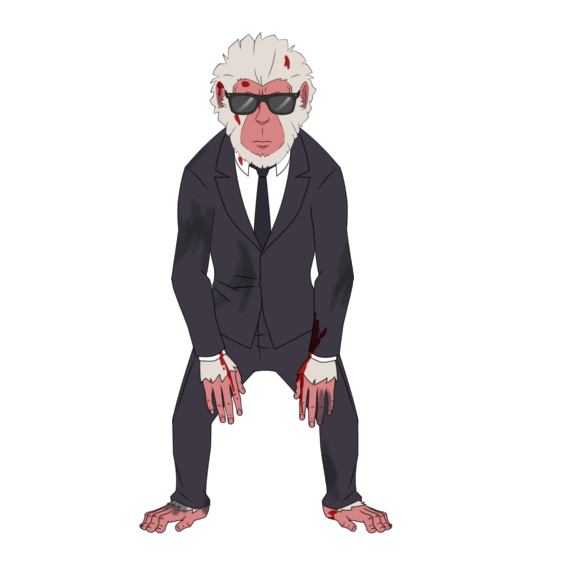
How has the reception of the series been, and what’s next for Floyd County Productions?
J. West: I think the reception has been great! I’m not very online, but the reviews are all pretty good right? I did see one commenter make fun of the “low frame rate” on one of the shots. Sorry bud, but we gotta cut corners sometimes. You try making drawings come to life! As far as what’s next, we made a second season of a show called Dicktown, with John Hodgeman.
We still make this show called Archer on FX, which is kind of “indie”. We made some really rad horror-comedy shorts that should be out in Fall 2022, and if I’m not supposed to say that, Marcus can edit this out. (Marcus here. They are rad.) Lots of development and secret stuff that I can’t talk about.
Victoria: Honestly, it kind of feels like Hit-Monkey has been flying under the radar a bit, but everyone I’ve recommended the show to has really liked it. I’m hoping more people take a chance and give it a watch!
Tim: The reception of the show has been good so far!
Jason: What’s next for Floyd County Productions? All I can say is, so many pilots. And so many NDAs. But exciting stuff is coming up!
- Curious to see more of Hit-Monkey? The full first season is currently streaming on Hulu.
- Think you have what it takes to work with the team at Floyd County Productions? Visit their website for a list of current job opportunities.
- Ready to start your next animated production? Artists can download a 21-day free trial of Toon Boom Harmony Premium.
The post Floyd County Productions on animating Hit-Monkey appeared first on Toon Boom Animation.
Courtesy: https://www.toonboom.com/floyd-county-productions-on-animating-hit-monkey






